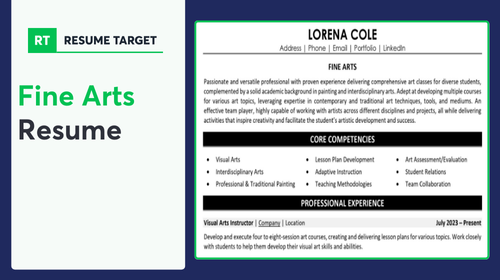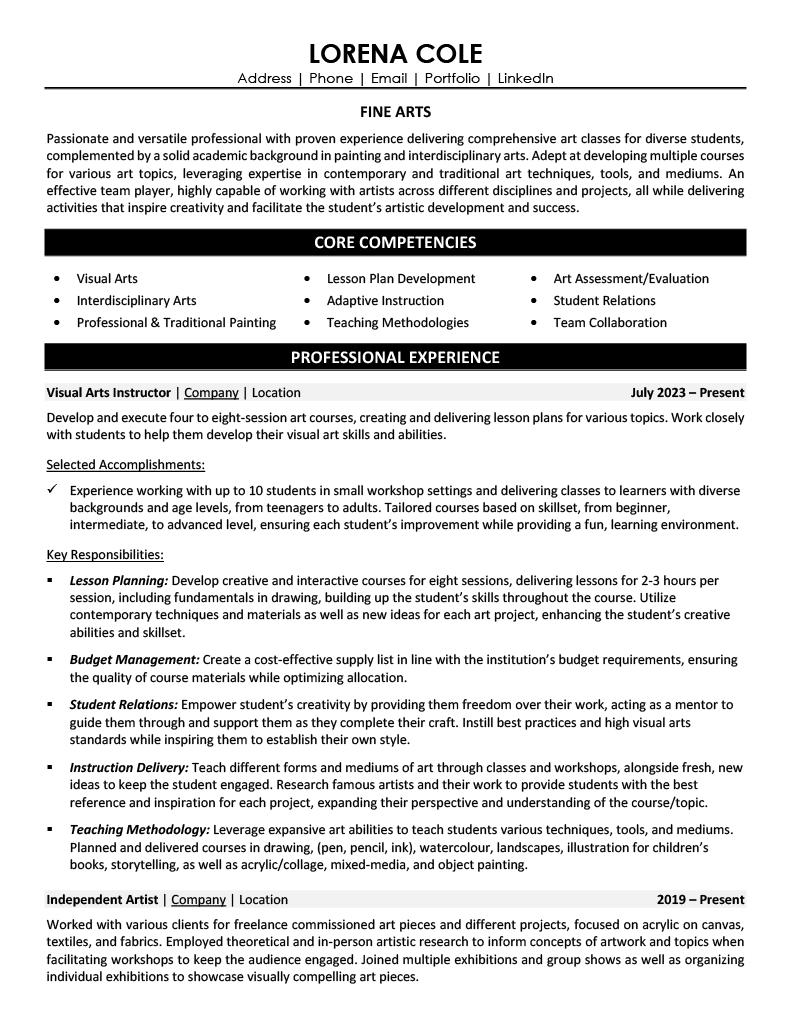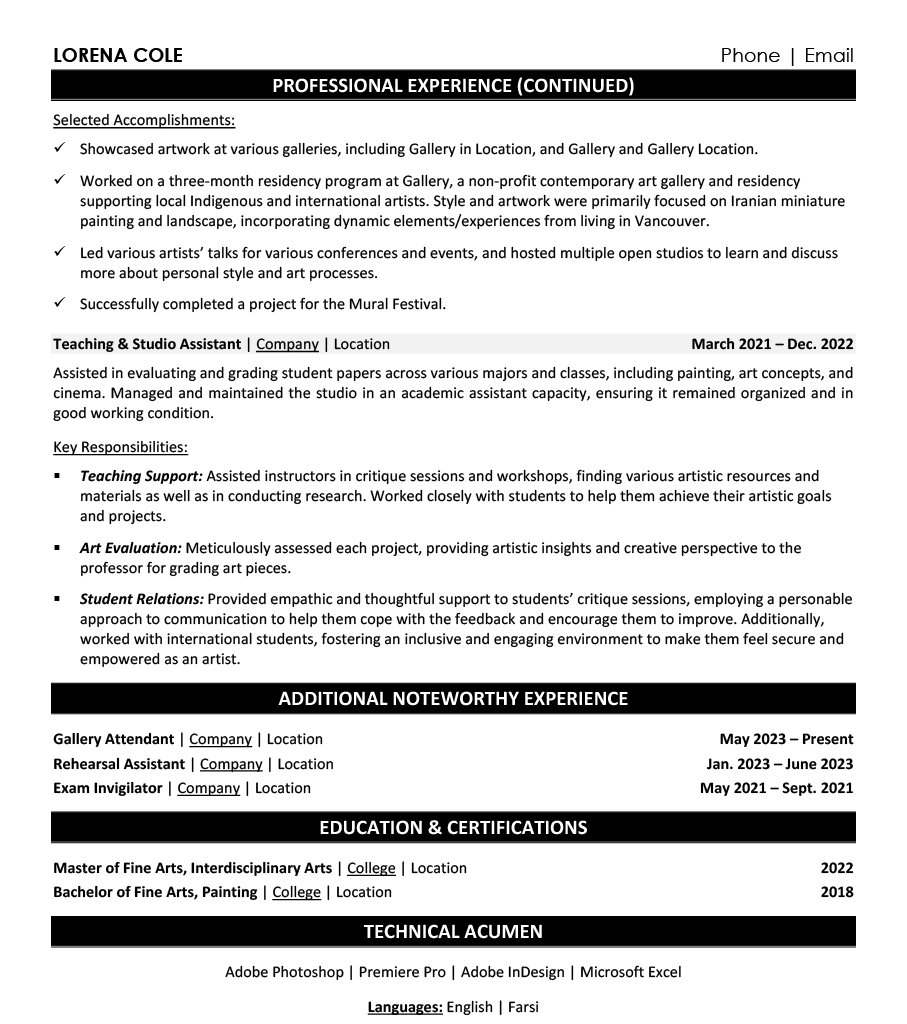

Creative portfolios showcase your art, but your resume is what gets you through the door. Many talented artists lose opportunities because their resumes don't speak the language of employers.
Are you struggling to translate your artistic achievements into business value? A well-crafted resume bridges the gap between creative excellence and professional requirements, turning your artistic journey into compelling qualifications.
Resume Target specializes in helping fine artists present their unique blend of creativity and practical skills. We transform your artistic experience into powerful professional credentials that catch the attention of galleries, museums, and creative employers.


From transforming blank canvases into captivating masterpieces to working with diverse materials like watercolors, oils, and digital tools, fine artists are the creative forces who bring visual stories to life in our world.
As a fine artist, you'll spend your days developing original concepts, experimenting with different techniques, and working closely with clients to create artwork that perfectly captures their vision while maintaining your unique artistic voice.
Whether you dream of showcasing your work in prestigious galleries, collaborating with commercial clients, or teaching others your craft, the path of a fine artist offers numerous opportunities to grow both creatively and professionally - let's explore how you can turn your artistic passion into a thriving career.
Let's talk about the exciting earning potential in Fine Arts! Your career as a fine artist can range from entry-level positions to highly lucrative senior roles, with opportunities to more than quadruple your income as you build your reputation and expertise. And guess what? The field offers both steady employment and freelance opportunities, giving you flexibility in how you shape your artistic career.
Figures from: U.S. Bureau of Labor Statistics
Fine Arts professionals can build exciting careers across galleries, museums, and creative studios. Your path might lead from hands-on artistic work to managing major exhibitions or directing cultural institutions.
To advance in the fine arts world, you'll need to combine creative expertise with business acumen and leadership capabilities.
- Advanced artistic techniques and medium mastery - Exhibition design and curation - Art market analysis and valuation - Strategic leadership and stakeholder managementFrom gallery assistant to art handler, the fine arts field offers multiple entry points where you can gain hands-on experience while building valuable industry connections and professional credibility.
To advance in fine arts, you'll need to develop both technical expertise and interpersonal abilities, with clear communication and the ability to give respectful, specific feedback being essential skills that will set you apart in the field.
Requirements from Art Therapy Credentials Board
From bustling art scenes in major metros to emerging creative hubs, Fine Arts careers span self-employment and institutions.
Figures from Scion Creative Staffing
Struggling to showcase your artistic vision and management expertise in a way that catches a gallery director's eye? This comprehensive, section-by-section guide will help you craft a compelling resume that artfully blends your creative achievements with your operational skills.
As a creative professional, condensing your artistic journey and diverse talents into a few powerful lines can feel as challenging as explaining the meaning behind an abstract masterpiece.
While you excel at visual expression and bringing ideas to life through various mediums, translating your unique artistic vision and technical abilities into words that resonate with gallery directors, creative directors, and potential clients requires a strategic approach that captures both your creative spirit and professional capabilities.
How would you describe your artistic identity and creative philosophy in a way that distinguishes you from other artists in your medium?
Reason: Your artistic perspective and approach are unique selling points that immediately tell employers and galleries what makes you different. This helps frame your entire resume within your distinctive creative context.
What combination of artistic disciplines and technical skills have you mastered that represent your versatility as a fine arts professional?
Reason: The fine arts field values multi-disciplinary abilities, and highlighting your range of skills immediately demonstrates your adaptability and comprehensive artistic capability.
How does your work contribute to or challenge contemporary artistic dialogue, and what broader impact do you aim to achieve through your art?
Reason: Employers and galleries want to understand how your work fits into the larger art world context and what value you bring to the cultural conversation. This helps position you as a thoughtful and purposeful artist.
As a fine artist, you need to showcase both your creative abilities and practical skills that demonstrate your professional versatility in the art world.
Your skills section should balance technical artistic abilities (like oil painting, sculpture, or digital art) with valuable professional competencies (such as gallery installation, art education, or project management) that make you a well-rounded creative professional.
Showcase your creative journey by organizing your experience into three impactful categories: your artistic role overview, exhibition and commission achievements, and core technical competencies that set you apart in the fine arts world.
Many Fine Arts professionals struggle to translate their creative accomplishments into concrete, business-focused results that hiring managers can understand. Transform your artistic journey into compelling metrics by connecting exhibitions, installations, and creative projects to measurable outcomes like audience reach, sales figures, and cultural impact.
The responsibilities section demonstrates how Fine Arts professionals contribute beyond creating artwork, showing your impact on cultural spaces, education, and creative development. Your duties should illustrate both technical artistic skills and professional capabilities in ways that showcase your value to galleries, institutions, or educational facilities.
Your formal arts education and professional certifications demonstrate your technical expertise and creative foundation to potential clients and galleries. List your most prestigious degrees and relevant certifications first, especially those from accredited fine arts institutions or recognized industry organizations.
Now that you've created a strong foundation using Resume Target's comprehensive resume writing guidelines, you're ready to transform your artist portfolio into a powerful career tool.
While many fine artists focus solely on customizing their portfolio and cover letter, tailoring your resume for each specific artistic opportunity—whether it's a gallery position, teaching role, or residency program—is equally crucial for success.
A strategically customized resume not only helps you navigate automated application systems by incorporating relevant artistic keywords and requirements, but also demonstrates to curators and hiring managers that your unique creative vision and skills align perfectly with their needs.
Ready to turn your resume into your competitive edge? Let's make your artistic expertise shine through targeted customization that will set you apart in the creative community!
Don't let a lack of professional experience hold you back from pursuing your creative career! Your journey to becoming a Fine Arts professional can start with a compelling resume that showcases your artistic talents and creative vision.
Instead of dwelling on unrelated work history, you'll want to focus on your artistic education, technical skills, and the portfolio pieces that demonstrate your creative abilities.
The key elements to highlight are your artistic techniques, software proficiency, and completed projects or exhibitions.
For more guidance on crafting your creative resume, check out the Student Resume Writing Guide to help transform your artistic journey into a professional opportunity.
Your creative journey and artistic accomplishments during your education are valuable assets that deserve to shine in your resume summary.
Transform your academic projects, exhibition experience, and technical skills into a compelling narrative that showcases your unique artistic vision and professional potential.
"Passionate and versatile Fine Arts graduate with extensive experience in multiple mediums including oil painting, digital art, and mixed media installations. Completed 15+ commissioned works while maintaining a 3.8 GPA in Fine Arts program, with two successful gallery exhibitions. Proficient in Adobe Creative Suite and traditional artistic techniques, with a growing social media following of 2,000+ art enthusiasts. Seeking to contribute creative vision and technical expertise to a dynamic artistic organization while developing a distinctive artistic voice."
Now's your chance to showcase the rich creative foundation and technical skills you developed during your arts education journey!
Transform your academic experience into compelling content by highlighting specialized studio courses, noteworthy exhibitions, and significant projects - like that semester-long installation piece or advanced color theory research that demonstrates your artistic vision and technical mastery.
The names of courses common to a degree/certification for Fine Arts include Art History, Ceramics, Color Theory, Contemporary Art, Drawing, Fine Arts Studio, Form and Content, Foundation Studio, Painting, Photography, Printmaking, Professional Practices in Fine Arts, Sculpture, and Studio Art [1]. A Fine Art college major requires courses like Drawing, Art History, Sculpture, and Textiles/Fibers [3]. Core classes include FA 224 Composition and Painting, FASCU 230 Sculpture 2, FASCU 231 Ceramics: Expressions in Clay, FND 110 Analysis of Form, FND 112 Figure Drawing, FND 125 Color and Design, ILL 133 Digital Media: Digital Manipulation, and IND 138 Model Making - Fall [2].Relevant Coursework: Art History | Color Theory | Drawing | Sculpture | Painting | Professional Practices in Fine Arts
Key Projects:
Mixed Media Installation: "Temporal Perspectives": Conceptualized and executed a large-scale mixed media installation exploring the intersection of traditional and contemporary art techniques while examining themes of time and perception.
Collaborative Exhibition Series: "Urban Dialogues": Led a team of four artists to create an interconnected series of works examining urban architecture and community spaces.
Transform your creative abilities, academic training, and hands-on studio experience into a compelling skills section that showcases your artistic expertise and technical proficiencies to potential galleries, studios, or employers.
As an emerging Fine Arts professional, your combination of technical abilities and creative vision positions you well for opportunities in galleries, museums, studios, or educational settings, where the demand for innovative artistic perspectives continues to grow.
Let's face it - trying to capture your creative vision, artistic achievements, and technical mastery on paper feels like painting a masterpiece with your eyes closed.
At Resume Target, we specialize in helping artists like you translate your creative portfolio into powerful professional narratives that resonate with galleries, institutions, and collectors.
Our team has helped countless fine artists showcase their artistic journey, from breakthrough exhibitions to collaborative installations, in ways that capture both technical expertise and creative impact.
With gallery seasons and exhibition deadlines approaching, now is the perfect time to transform your artistic story into a compelling professional narrative - let's start crafting your standout resume today.
Impress any hiring manager with our arts resume writing service. We work with all career levels and types of arts professionals.
Learn More → Arts Resume Writing Services